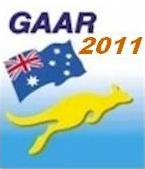| This section includes
hints, tips and questions and answers regarding the GAAR generally, and the GAAR 2011
specifically. The GAAR Forum is provided for more interactive discussion on the
subject and as an area to seek more specific advice. General questions from the GAAR
Forum will be placed here, as considered appropriate. Aircraft Selection Considerations:
- any piston or radial engined aircraft that flew in the 1930s to 1950s.
- range of at least 350 nm;
- fitted with ADF and VOR is ideal;
- if not fitted with ADF and VOR, ADF is recommended, otherwise most of the event has to
be flown by "dead reckoning"; and
- fitted with DME would also be good, but not absolutely necessary.
Route Information:
- 10 Legs (some with sub sectors);
- total event distance of 2387 nm.
Q1. What is the GAAR?
A1. The GAAR is the Great Australian Air Rally and is an annual
event for flight simulation enthusiasts conducted by Bluegrass Airlines, typically in
February of each year.
Q2. Who can particpate in the
GAAR?
A2. The GAAR is open to flight simulation pilots of all skill
levels, from the novice to the more experienced pilots.
Q3. What fight simulator is
used for the GAAR?
A3. The GAAR is officially supported in FS9 and FSX.
Q4. Can I use another flight
simulator?
A4. Yes, but it will not be supported with required files and
results will not be included in the official results.
Q5. What aircraft can I fly
in the GAAR?
A5. Any radial or other piston engined aircraft that flew in the
period 1930's to 1950's. This includes any subsequent production models, e.g. Cessna
172 - first flew in 1956 (therebt making it eligible) with current production models being
the 172R and 172S (or 172SP). A model variant will only become ineligible if it
compromises the rule on engines, i.e. fitted with a turboprop, turbojet, turbofan and
other such engine.
Q6. Can I fly multiple
aircraft in the GAAR?
A6. Yes, but you must submit a separate Pilot Registration for each
aircraft entered.
Q7. How is the competition
run?
A7. The GAAR is not a race nor a competition. It is an event
in which individuals participate against their own flying ability by navigating over a
series of Flight Legs on which they are aiming to fly as close as possible to an
individually calculated "target time".
Q8. Why do some Flight Leg
distances appear to have large distance and navigation errors when I do my flight
planning?
A8. The Flight Legs are not always flown "as the crow
flies" (straight line). Detailed navigation instructions will be provided.
Q9. I have other commitments
during the official February conduct period that will interfere with participating, can I
fly the GAAR in advance?
A9. Yes, you can. Required flight files will be available for
download from 00:01 hrs UTC, 15 Jan and you can submit PIREPS from 00:01 hrs UTC, 01 Feb.
Q10. Can I fit "ferry
tanks" to my chosen aircraft?
A10. Yes, an aircraft may be fitted with "ferry tanks" to
effect a minor increase in the range of the aircraft. Where "ferry tanks"
are used, the total aircraft weight must remain inside the specified maximum take-off
weight (MTOW) for the aircraft and / or the capacity of the "ferry tanks" must
be no greater than 10% of the original specified fuel capacity for the aircraft.
Q11. How is my target time
calculated?
A11. The 'Target Time is based on the 'Test Flight Time'. It
is applied to the distance for each respective Flight Leg with elements factored in for
the various stages of flight, Climb, Cruise, Descent and Circuit. The Climb
component factors in a reduced speed and distance covered, as does the Circuit component,
which is based on a combined Downwind, Base and Final Leg of approximately 12 nm. |
 Great Australian Air Rally 2011
Great Australian Air Rally 2011 
 GAAR 2011
GAAR 2011 
